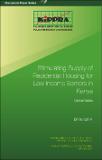Discussion Paper No. 167 of 2014 on Stimulating Supply of Residential Housing for Low Income Earners in Kenya
| dc.date.accessioned | 2021-01-07T06:02:27Z | |
| dc.date.available | 2021-01-07T06:02:27Z | |
| dc.date.issued | 2014 | |
| dc.identifier.uri | http://repository.kippra.or.ke/handle/123456789/2531 | |
| dc.description.abstract | The need to have shelter is indispensable to humanity and is classified among the top three basic needs. However, increase in population, scarcity of fixed assets such as land, escalating house prices, and the rising cost of living have made living inadequate and decent housing an illusion for many Kenyans. We use time series data, 1980-2011, drawn from the Kenya National Bureau of Statistics (KNBS) to determine the factors that would stimulate the residential housing market for low income earners. The Instrumental Variable estimation technique is applied for this study. The study found that Mombasa had a minimum house price of Ksh 2.24 million. This is already above the low cost amount provided by the Housing Bill 2011 for low income earners. Nairobi, on the other hand, had a minimum cost of supply of Ksh 2.12 million. | en |
| dc.language.iso | en | en |
| dc.publisher | The Kenya Institute for Public Policy Research and Analysis (KIPPRA) | en |
| dc.relation.ispartofseries | DP/167/2014 | |
| dc.subject | Housing Market | en |
| dc.subject | Residential Housing | en |
| dc.subject | Employment Creation | en |
| dc.subject | Housing Systems | en |
| dc.subject | Poverty Reduction | en |
| dc.title | Discussion Paper No. 167 of 2014 on Stimulating Supply of Residential Housing for Low Income Earners in Kenya | en |
| dc.type | KIPPRA Publications | en |
| ppr.contributor.author | Vuluku, Gayline | en |
Files in this item
This item appears in the following Collection(s)
-
Discussion Papers [326]

